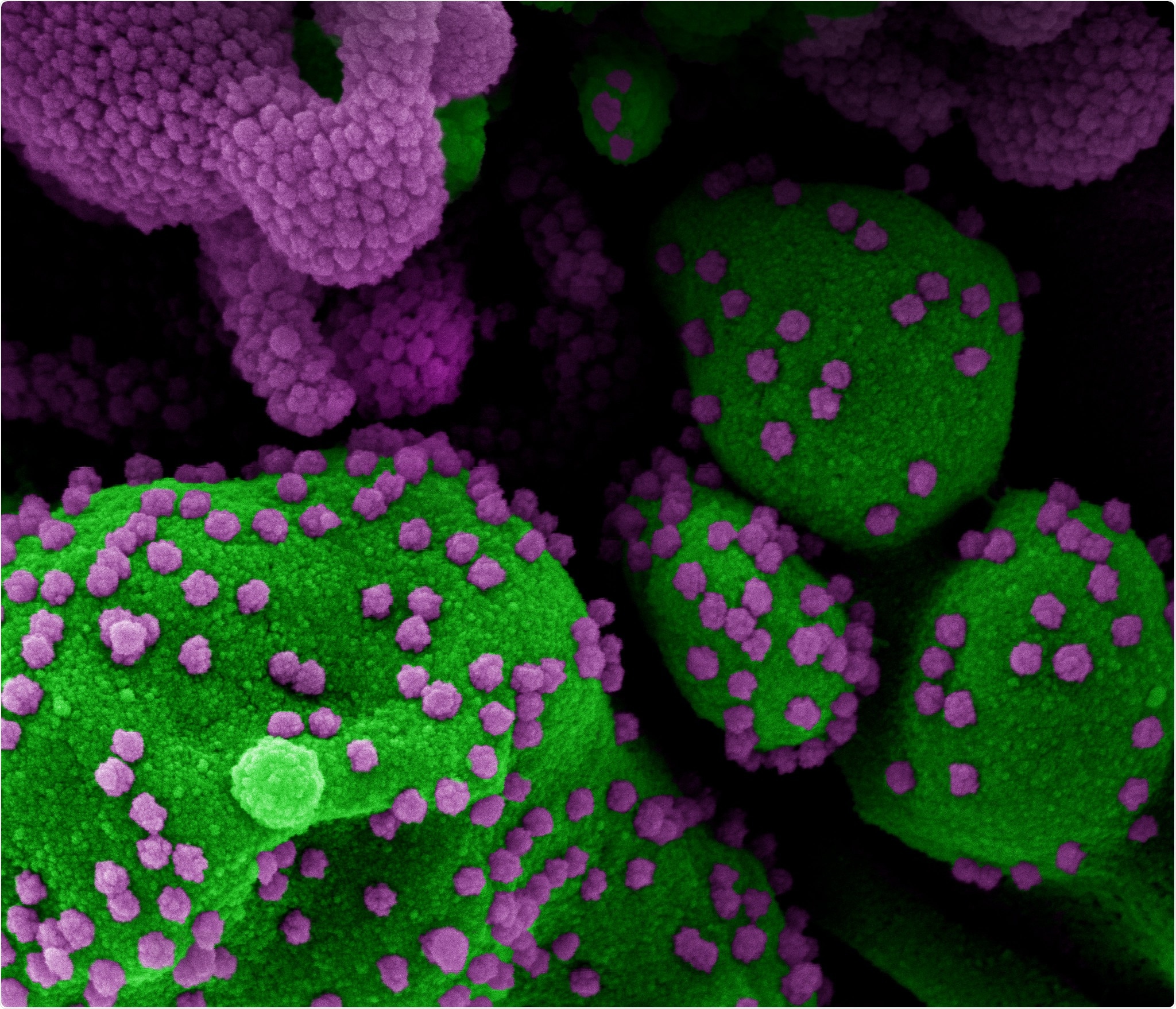
Colorized scanning electron micrograph of an apoptotic cell (green) heavily infected with SARS-CoV-2 virus particles (purple), isolated from a patient sample. Image at the NIAID Integrated Research Facility (IRF) in Fort Detrick, Maryland. Credit: NIAID
Administration of the nasal spray in an animal model attained high concentrations of the drug ivermectin (IVM) in the nasopharyngeal tissue – a primary site for SARS-CoV-2 entry and replication.
IVM is a macrocyclic lactone discovered in 1975 and developed in the early eighties to treat parasitic infections in animals and humans.
In the current study, the nasal IVM spray was shown to be safe and well-tolerated in pigs, with no local or systemic adverse events observed in the animals.
“To the best of our knowledge, this is the first time that a nasal IVM spray formulation is developed and its safety and pharmacokinetic performance determined in a pig model, the most appropriate animal model to use in translational research into humans,” said Jorge Errecalde (Universidad Nacional de La Plata) and colleagues.
A pre-print version of the paper is available in the server bioRxiv*, while the article undergoes peer review.
IVM has already been safely used for decades
IVM has been a safe and effective treatment for tropical diseases such as scabies and helminthiases for decades.
Over recent years, emerging knowledge has guided the repurposing of IVM towards treating other diseases, and the drug’s antibacterial and antiviral activities have been observed experimentally.
“Furthermore, there is now available information from a randomized clinical trial on IVM antiviral activity in SARS-CoV-2 infected patients,” say Errecalde and team.
SARS-CoV-2 initially colonizes in the nasopharynx
Since the first cases of SARS-CoV-2 were identified in Wuhan, China, late last year, studies have shown that the virus initially colonizes in the nasopharynx (NP) tissue.
From there, the virus can be transmitted before any symptoms have even been developed.
As SARS-CoV-2 replicates in this tissue, initial symptoms such as dry cough and fever develop, along with colonization of the lung parenchyma.
Given the virus's gateway, nasal administration that would deposit IVM in the upper respiratory tract may expose SARS-CoV-2 to high concentrations of the drug.
“Hence, a reduction of the viral load at the beginning of the infection, preventing viral replication, transmission and disease aggravation might be achieved,” say the researchers.
Testing the safety and pharmacokinetics of IVM in piglets
The team assessed the safety and pharmacokinetic performance of either a single or double dose of nasal IVM spray (2 mg, 1 puff/nostril) or tablets (0.2 mg/kg) administered orally in piglets.
The researchers say piglets were chosen as the test animal because the pig has anatomical and physiological similarities to humans and is one of the most used animal species in translational research.
Here, “the assessment of safety and pharmacokinetics for the novel IVM spray formulation in a pig model is described for the first time,” they write.
The team determined the IVM concentration profiles in NP tissue, lung tissue, and plasma at different times following the two different administration routes.
The treatment was well tolerated
The IVM treatment was well tolerated, with no local or systemic adverse events observed across the entire study period, whether the drug was administered orally or using a single or double dose of the spray formulation.
Following nasal administration, the highest IVM concentrations were always identified in the NP and lung tissues. A second dose of the spray significantly increased IVM concentrations in NP and lung tissue, compared with the use of a single dose.
Using the oral tablet administration as a reference, the team assessed the relationship between IVM concentrations in the target tissue at 6 hours following the spray application.
The spray/oral IVM concentration ratios increased significantly in both tissues following a repeat of the spray application.
Potential benefits of nasal IVM spray should be evaluated in clinical trials
“Compared to the oral administration, the intranasal administration in humans may provide fast, high, and persistent IVM concentration at the NP tissue area at much lower doses,” say Errecalde and colleagues.
The researchers say these potential benefits should be evaluated in clinical trials.
“In the same direction, further research is also needed to evaluate the potential advantages of a combined nasal plus oral treatment regimen to further contribute to IVM repurposing in COVID-19 therapy,” concludes the team.

 This news article was a review of a preliminary scientific report that had not undergone peer-review at the time of publication. Since its initial publication, the scientific report has now been peer reviewed and accepted for publication in a Scientific Journal. Links to the preliminary and peer-reviewed reports are available in the Sources section at the bottom of this article. View Sources
This news article was a review of a preliminary scientific report that had not undergone peer-review at the time of publication. Since its initial publication, the scientific report has now been peer reviewed and accepted for publication in a Scientific Journal. Links to the preliminary and peer-reviewed reports are available in the Sources section at the bottom of this article. View Sources
Journal references:
- Preliminary scientific report.
Errecalde J, et al. Ivermectin repurposing for COVID-19 therapy: Safety and pharmacokinetic assessment of a novel nasal spray formulation in a pig model. bioRxiv, 2020. doi: https://doi.org/10.1101/2020.10.23.352831, https://www.biorxiv.org/content/10.1101/2020.10.23.352831v1
- Peer reviewed and published scientific report.
Errecalde, Jorge, Adrian Lifschitz, Graciela Vecchioli, Laura Ceballos, Francisco Errecalde, Mariana Ballent, Gustavo Marín, et al. 2021. “Safety and Pharmacokinetic Assessments of a Novel Ivermectin Nasal Spray Formulation in a Pig Model.” Journal of Pharmaceutical Sciences 110 (6): 2501–7. https://doi.org/10.1016/j.xphs.2021.01.017. https://www.sciencedirect.com/science/article/pii/S0022354921000320.